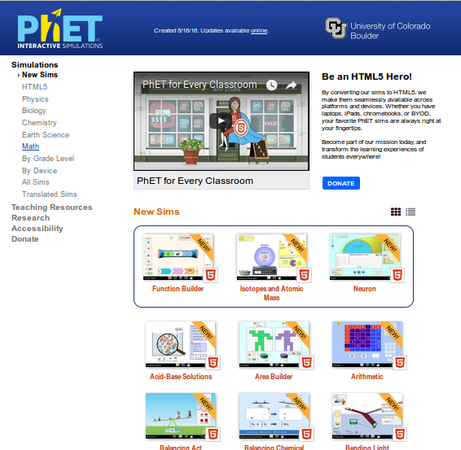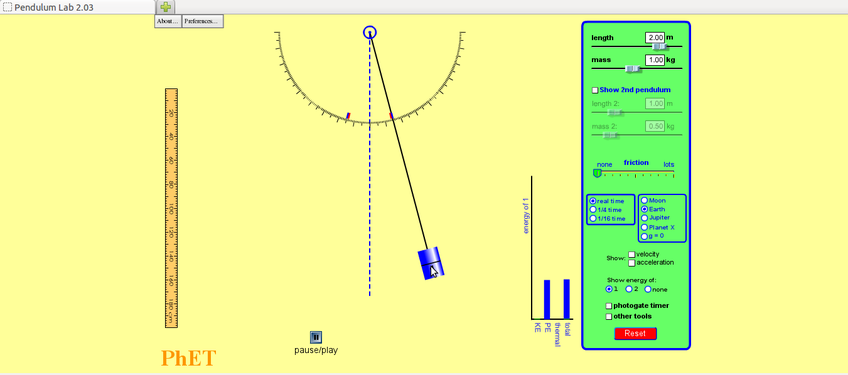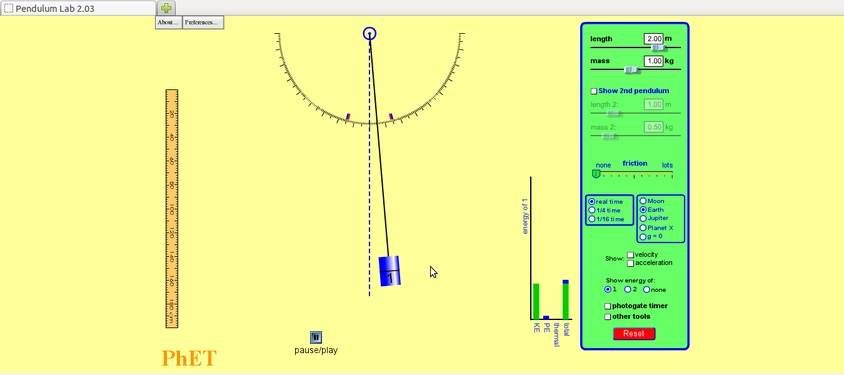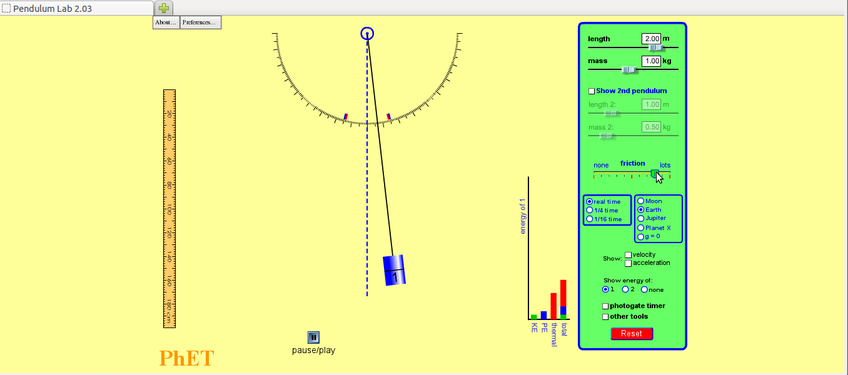Difference between revisions of "Learn PhET"
| (26 intermediate revisions by 7 users not shown) | |||
| Line 1: | Line 1: | ||
| − | + | {{Template:Book-sidebar}} | |
| − | + | ''[http://karnatakaeducation.org.in/KOER/index.php/%E0%B2%AB%E0%B3%86%E0%B2%9F%E0%B3%8D_%E0%B2%95%E0%B2%B2%E0%B2%BF%E0%B2%AF%E0%B2%BF%E0%B2%B0%E0%B2%BF ಕನ್ನಡದಲ್ಲಿ ನೋಡಿ]'' | |
| − | + | ===Introduction=== | |
| − | == | + | PhET is an educational resource that contains computer demonstrations of experiments and activities. It is a collection of science simulations that can be integrated in classroom teaching-learning. |
| − | + | ====Basic information==== | |
| − | |||
| − | |||
| − | |||
| − | |||
| − | |||
| − | |||
| − | |||
| − | |||
| − | == | ||
| − | |||
| − | |||
| − | |||
| − | |||
| − | = | ||
| − | == | ||
| − | |||
| − | |||
{| class="wikitable" | {| class="wikitable" | ||
|- | |- | ||
| − | | | + | |ICT Competency |
| − | + | |PhET is a free and open source educational software for subject resource creation. (Science and Maths) It is a collection of free, interactive, research-based science and mathematics simulations. | |
|- | |- | ||
| − | | | + | |Educational application and relevance |
| − | + | |All simulations are free and open source. Simulations allow students to explore in detail scientific concepts and phenomena. The simulations show dynamic processes and these can be slowed down, sped up, or paused, depending on the concept being shown; the invisible is made visible; and multiple representations are linked. The sims can be easily adjusted by the teacher during discussions. These features often make simulations more effective for learning and more practical to use than static drawings or live demos. Simulations can also be used for formative assessments. | |
| − | |||
| − | |||
| − | |||
|- | |- | ||
| − | | | + | |Version |
| − | | | + | |PhET Version - 1.1.7 |
|- | |- | ||
| − | | | + | |Configuration |
| − | + | |No specific configuration requirements. | |
| − | + | |- | |
| − | + | |Other similar applications | |
| − | + | |[http://Vlab.co.in Virtual Laboratory] , [http://chemcollective.org/vlab_download Chemistry virtual lab], [http://virtualbiologylab.org/ Biology virtual lab] | |
| − | | | + | |- |
| − | + | |The application on mobiles and tablets | |
| + | |PhET Sims app can be downloaded from android versions Google Playstore. | ||
| + | |- | ||
| + | |Development and community help | ||
| + | |The simulations are written in Java, Flash or HTML5, and can be run on-line or downloaded to your computer. It is an initiative from University of Colorado. [https://phet.colorado.edu/ Official Website] | ||
|} | |} | ||
| − | ==File | + | ====Overview of Features==== |
| + | PhET is a virtual lab with simulations for sciences and math. Simulations are categorized by physical science biological science and earth sciences. Simulations are also classified by grade level and by device. Translated simulations are also available. | ||
| + | |||
| + | ==== Installation ==== | ||
| + | If its not available under Applications > Education, then you install PhET in your computer through the following steps | ||
| + | |||
| + | Select System tools → Preferences → Main menu → Select Education→ Click on New Item → Name – PhET → Command- firefox /opt/PhET/index.html → OK | ||
| + | |||
| + | ===Working with the application=== | ||
| + | ====Working with PhET application==== | ||
| + | <gallery mode="packed" heights="300px" caption="Opening PhET & Simulations"> | ||
| + | File:PhEt main page.png|PhET main page | ||
| + | File:PhET Simulations page.png|PhET Simulations | ||
| + | </gallery> | ||
| + | #You can find PhET under Applications> Education> Science. PhET is an educational resource that contains computer demonstrations of experiments and activities. | ||
| + | #When you click on "Play with Simulations" – it will open simulations in various subjects. You just click on Physics and scroll down to the simulation on Pendulum Lab. When you want to open a simulation, click on the green rectangle which says “Run Now”. | ||
| + | ====Working with Pendulum Simulation==== | ||
| + | The power of a simulation is in capturing different points in a phenomenon and using discussion questions to facilitate student learning. The following example describes a lesson using a simulation.<gallery mode="packed" heights="250px" caption="Working with Pendulum Simulation"> | ||
| + | File:PhET_1_pendulum.png| | ||
| + | File:PhET_2_pendulum.png| | ||
| + | </gallery> | ||
| + | #Notice where the pendulum is: | ||
| + | ##is it higher, lower or at the same level as the central position? | ||
| + | ##Notice the graph – what are the two variables on the bar chart? | ||
| + | ##What do you think will happen to the pendulum next? | ||
| + | #Notice where the pendulum is – has it moved? What can you say about its movement? Notice the graph – what are the variables on the bar chart? What are the values of PE and KE as compared to total energy? | ||
| − | == | + | <gallery mode="packed" heights="250px"> |
| − | + | File:PhET_3_pendulum.png| | |
| + | File:PhET_4_pendulum.png| | ||
| + | </gallery> | ||
| − | + | #Notice where the pendulum is: | |
| + | ##Has it moved? Is it higher or lower than the central position? | ||
| + | ##Did you notice anything about the speed of the bob as it moves from one extreme position to another? | ||
| + | ##Notice the graph – what are the variables on the bar chart? | ||
| + | ##What has happened to the values of the KE and PE as compared to total energy? | ||
| + | ##What do you think is happening? Is this what you will think will happen when you try this experiment? Why? Why not? What is different? | ||
| + | #Notice where the pendulum is: | ||
| + | ##This extreme position to the right is at a different height than. Why? What role does friction play and where does it come from | ||
| + | ##Look at the graph – what are the variables in the bar chart? Where has the thermal energy come from? What do you expect will happen to the simple pendulum? | ||
| − | == | + | ====Saving the files and formats==== |
| + | PhET simulation does not have its own file format, which you can save the web link in .html format. However you can create image files of the PhET simulation you are working on, by using the Screenshot application. [[Learn Record My Desktop|Screencast recording]] of a simulation can be done to create resources for the classroom. | ||
| − | = | + | ====Advanced features==== |
| − | + | ||
| − | + | ===Ideas for resource creation=== | |
| − | + | You can use the activities in PhET to create resources in video format as mentioned earlier. You can also create a set of screenshots of a simulation and present it along with explanatory text as a [[Learn LibreOffice Impress|slide show]] | |
| − | |||
| − | |||
| − | |||
| − | |||
| − | |||
| − | |||
| − | |||
| − | |||
| − | |||
| − | |||
| − | = | + | ===References=== |
| + | [https://phet.colorado.edu/ Colorado University] | ||
| − | + | [[Category:Explore an application]] | |
| − | |||
| − | |||
Latest revision as of 14:21, 11 August 2018
Introduction
PhET is an educational resource that contains computer demonstrations of experiments and activities. It is a collection of science simulations that can be integrated in classroom teaching-learning.
Basic information
| ICT Competency | PhET is a free and open source educational software for subject resource creation. (Science and Maths) It is a collection of free, interactive, research-based science and mathematics simulations. |
| Educational application and relevance | All simulations are free and open source. Simulations allow students to explore in detail scientific concepts and phenomena. The simulations show dynamic processes and these can be slowed down, sped up, or paused, depending on the concept being shown; the invisible is made visible; and multiple representations are linked. The sims can be easily adjusted by the teacher during discussions. These features often make simulations more effective for learning and more practical to use than static drawings or live demos. Simulations can also be used for formative assessments. |
| Version | PhET Version - 1.1.7 |
| Configuration | No specific configuration requirements. |
| Other similar applications | Virtual Laboratory , Chemistry virtual lab, Biology virtual lab |
| The application on mobiles and tablets | PhET Sims app can be downloaded from android versions Google Playstore. |
| Development and community help | The simulations are written in Java, Flash or HTML5, and can be run on-line or downloaded to your computer. It is an initiative from University of Colorado. Official Website |
Overview of Features
PhET is a virtual lab with simulations for sciences and math. Simulations are categorized by physical science biological science and earth sciences. Simulations are also classified by grade level and by device. Translated simulations are also available.
Installation
If its not available under Applications > Education, then you install PhET in your computer through the following steps
Select System tools → Preferences → Main menu → Select Education→ Click on New Item → Name – PhET → Command- firefox /opt/PhET/index.html → OK
Working with the application
Working with PhET application
- Opening PhET & Simulations
- You can find PhET under Applications> Education> Science. PhET is an educational resource that contains computer demonstrations of experiments and activities.
- When you click on "Play with Simulations" – it will open simulations in various subjects. You just click on Physics and scroll down to the simulation on Pendulum Lab. When you want to open a simulation, click on the green rectangle which says “Run Now”.
Working with Pendulum Simulation
The power of a simulation is in capturing different points in a phenomenon and using discussion questions to facilitate student learning. The following example describes a lesson using a simulation.
- Working with Pendulum Simulation
- Notice where the pendulum is:
- is it higher, lower or at the same level as the central position?
- Notice the graph – what are the two variables on the bar chart?
- What do you think will happen to the pendulum next?
- Notice where the pendulum is – has it moved? What can you say about its movement? Notice the graph – what are the variables on the bar chart? What are the values of PE and KE as compared to total energy?
- Notice where the pendulum is:
- Has it moved? Is it higher or lower than the central position?
- Did you notice anything about the speed of the bob as it moves from one extreme position to another?
- Notice the graph – what are the variables on the bar chart?
- What has happened to the values of the KE and PE as compared to total energy?
- What do you think is happening? Is this what you will think will happen when you try this experiment? Why? Why not? What is different?
- Notice where the pendulum is:
- This extreme position to the right is at a different height than. Why? What role does friction play and where does it come from
- Look at the graph – what are the variables in the bar chart? Where has the thermal energy come from? What do you expect will happen to the simple pendulum?
Saving the files and formats
PhET simulation does not have its own file format, which you can save the web link in .html format. However you can create image files of the PhET simulation you are working on, by using the Screenshot application. Screencast recording of a simulation can be done to create resources for the classroom.
Advanced features
Ideas for resource creation
You can use the activities in PhET to create resources in video format as mentioned earlier. You can also create a set of screenshots of a simulation and present it along with explanatory text as a slide show






